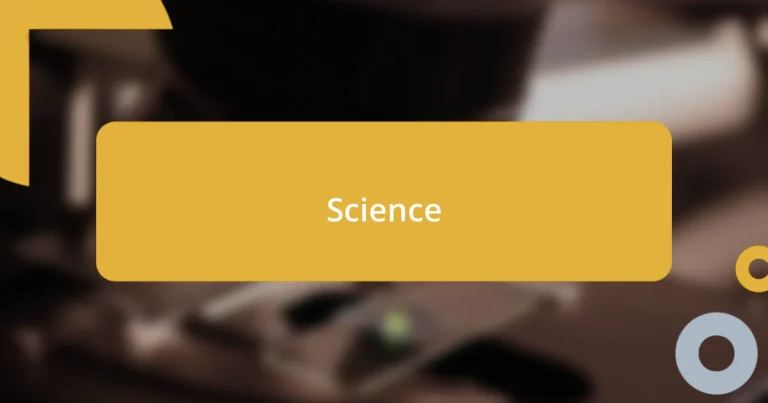Key takeaways:
- Feedback should be viewed as a catalyst for growth and self-discovery, enhancing both personal and professional development.
- Constructive feedback is most effective when it is specific, delivered in a supportive tone, and timely, creating a safe environment for improvement.
- Receiving feedback can be transformative by fostering an open mindset, actively seeking clarification, and reflecting on the advice to facilitate actionable steps for growth.
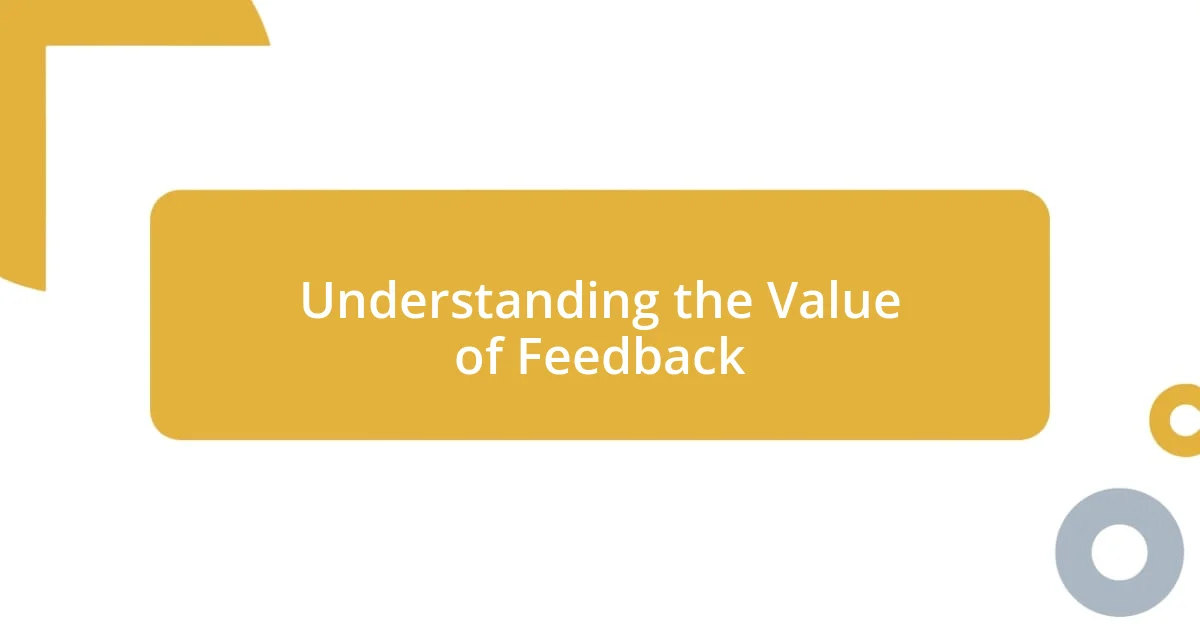
Understanding the Value of Feedback
Feedback is like a mirror reflecting both strengths and areas for improvement, and I’ve found that accepting it can be transformative. One time, I received a piece of feedback on my public speaking skills that cut deep; it was tough to hear, but it pushed me to seek coaching that completely changed my approach. That moment taught me that feedback isn’t just criticism—it’s an opportunity for growth and self-discovery.
Have you ever received feedback that put you on the spot but ultimately led to a breakthrough? I remember a project review meeting where my boss called out specific issues in my presentation. Initially, it felt like a punch to the gut, but later, I realized it was a turning point. It made me more mindful in my work and added a layer of confidence in my abilities.
In my experience, embracing feedback fosters a culture of continuous improvement. I’ve seen teams thrive when they regularly share constructive feedback, allowing them to innovate and build stronger relationships. When we view feedback as a dialogue rather than a monologue, we open the door to collaboration and deeper understanding, which enriches our professional and personal lives.
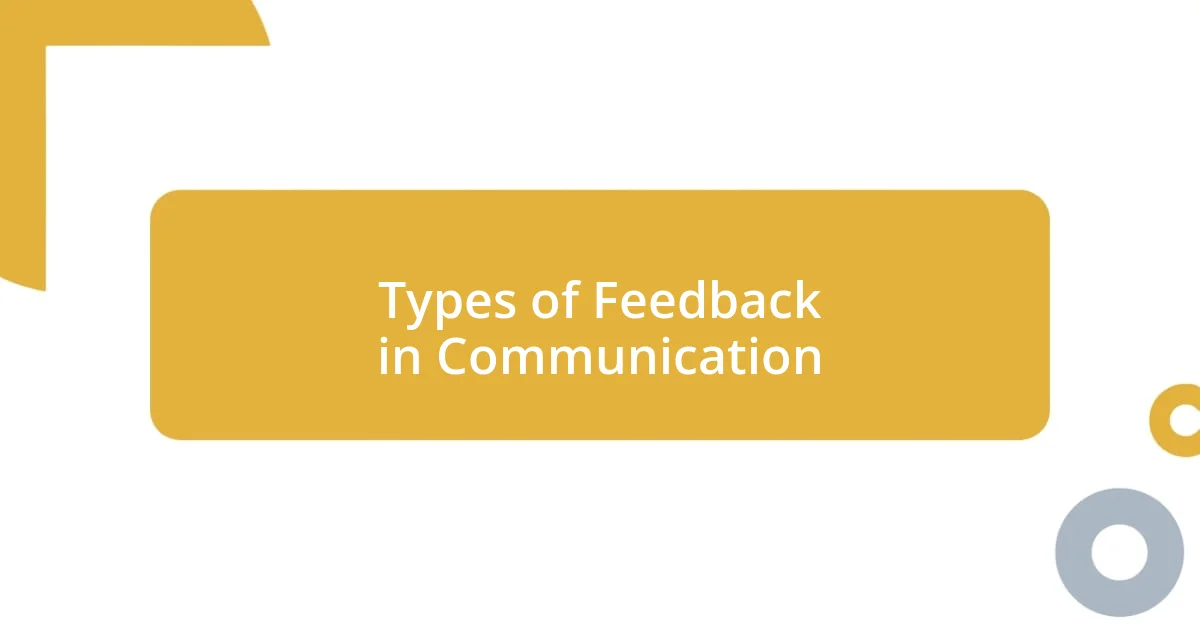
Types of Feedback in Communication
Feedback in communication can take various forms, and I’ve found that distinguishing these types can immensely enhance our interactions. For instance, some feedback is corrective, aimed at pinpointing mistakes or areas for improvement, while other forms may be more reinforcing, boosting confidence and validating efforts. I remember during a team project, a colleague offered not just a critique but a suggestion that made all the difference. It transformed my approach and left me feeling supported rather than judged.
Here are the common types of feedback in communication:
- Constructive Feedback: Focuses on improvement, offering specific suggestions to enhance performance.
- Positive Feedback: Highlights strengths and achievements, reinforcing good behavior or skills.
- Negative Feedback: Addresses areas needing improvement, often highlighting mistakes, but can sometimes be perceived as harsh.
- Evaluative Feedback: Involves assessments or ratings, providing a clear metric of performance against standards.
- Descriptive Feedback: Focuses on observations without judgment, creating a non-threatening environment for discussion.
Each type plays a vital role in shaping how we comprehend and act on the information shared. I often find that blending these types can create a more comprehensive and digestible experience, making the difficult conversations feel more balanced and constructive.
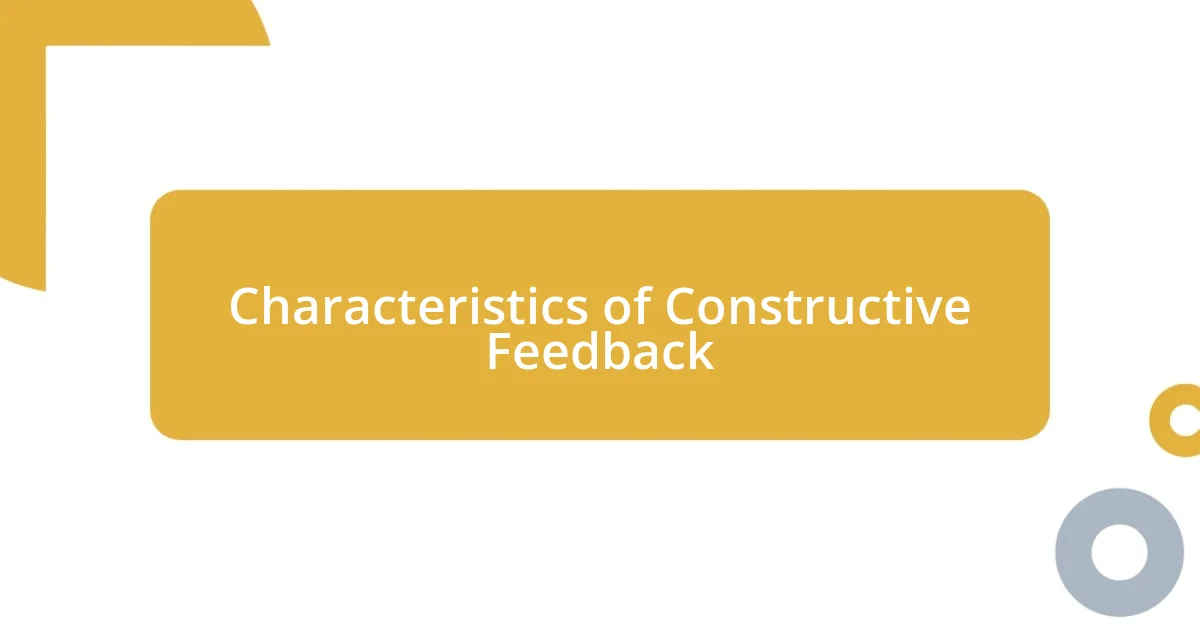
Characteristics of Constructive Feedback
When I think about constructive feedback, I realize there are a few characteristics that really elevate the experience. It should be specific, which means the feedback doesn’t just say “do better” but rather highlights concrete areas for improvement. I remember receiving feedback on a report where the reviewer pointed out not just that my analysis was off, but which particular section created confusion. That clarity helped me understand exactly what I needed to work on, shifting my perspective from feeling overwhelmed to feeling focused.
Another vital component is a supportive tone. I once had a mentor who framed feedback in a way that blended criticism with encouragement. When he critiqued my coding skills, he didn’t just list what was wrong; he paired each point with advice on how to improve. This balanced approach made me feel safe to take risks and learn without fear of harsh judgment. It reinforced my belief that growth comes from a place of support, not just from criticism.
Lastly, timing matters significantly in feedback. I’ve found that receiving it soon after an event or effort allows for a fresh perspective. For instance, after delivering a presentation, I asked my colleague for feedback right away. Their immediate insights helped me tweak my delivery for future talks while the experience was still fresh in my mind. It felt much more like a collaborative effort, enhancing my performance next time.
| Characteristic | Importance |
|---|---|
| Specificity | Helps pinpoint exact areas of improvement. |
| Supportive Tone | Encourages a safe environment for growth. |
| Timeliness | Ensures feedback is relevant and actionable. |
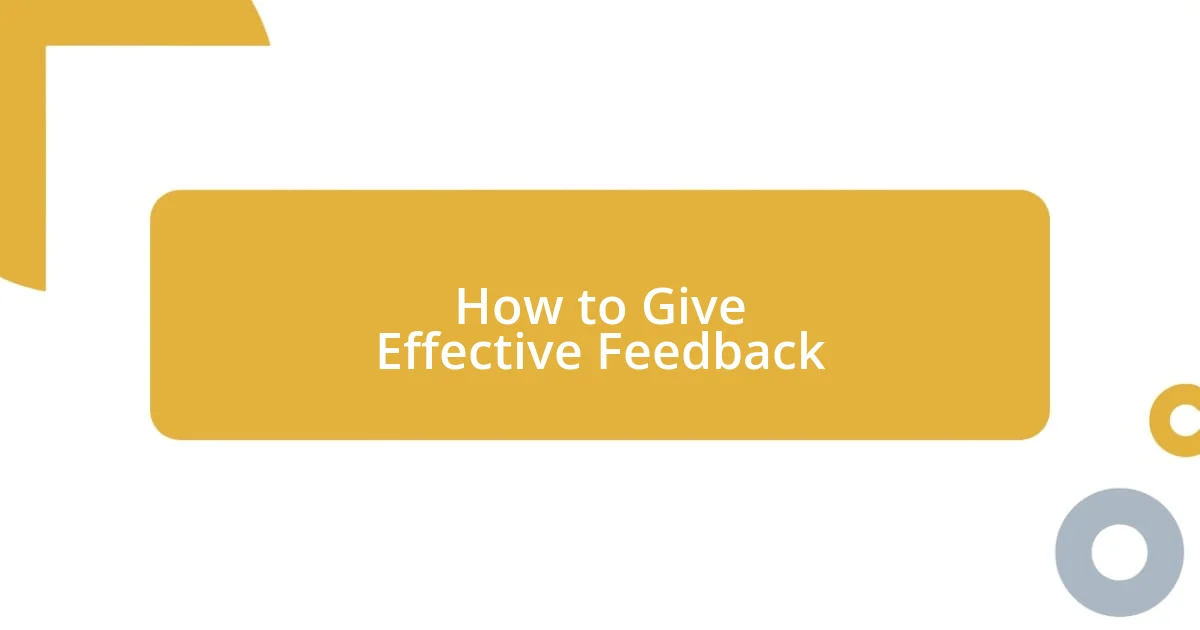
How to Give Effective Feedback
When giving feedback, clarity is crucial. Instead of general comments, I believe in providing clear examples that illustrate my points. One time, I reviewed a friend’s artwork and told them exactly what caught my eye—like how their use of color created depth. That specificity not only made my feedback helpful but also showed my genuine appreciation for their effort.
I also think about the emotional impact of feedback. During a performance review, I remember how one manager emphasized my strengths before discussing areas for growth. It was a game-changer! That approach made me feel valued and motivated to tackle the challenges ahead. How often do we notice that a little positivity can boost someone’s confidence?
Finally, I’ve learned that feedback should foster a two-way conversation. It’s not just about sharing my thoughts; it’s also about inviting dialogue. In a team setting, I encourage my colleagues to share their perspectives on my feedback. This collaborative approach not only deepens our relationships but also generates a richer understanding of the issues at hand. It’s amazing how open communication can transform feedback from a simple task into a shared journey of growth.
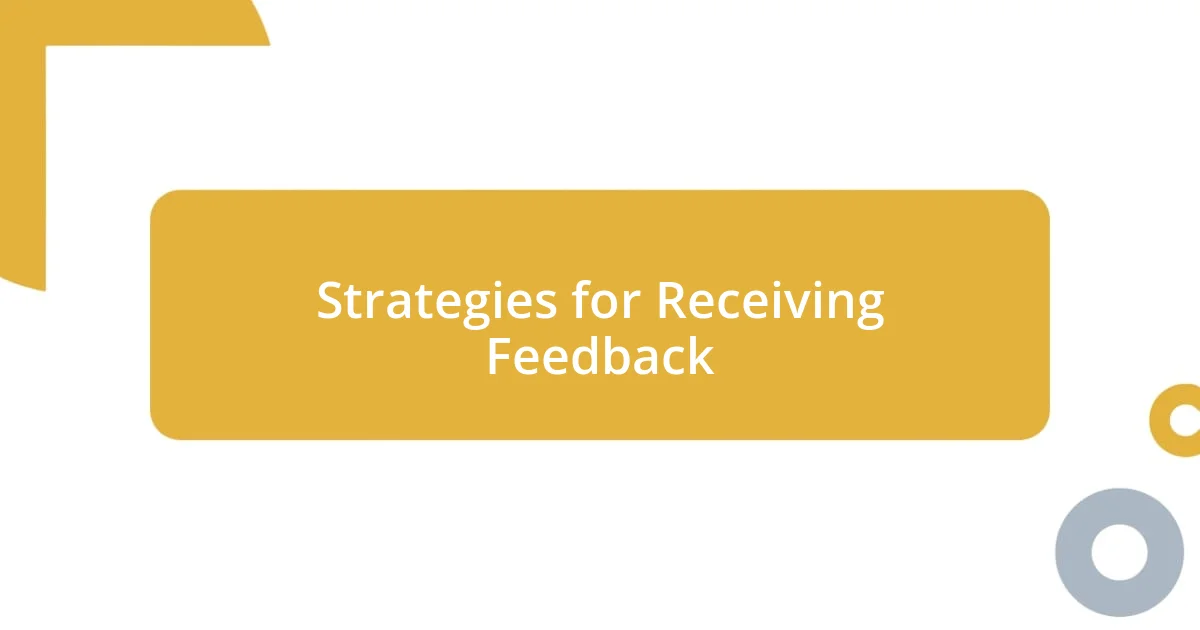
Strategies for Receiving Feedback
When it comes to receiving feedback, it’s essential to establish an open mindset. I remember a time when I allowed my initial defensiveness to cloud my judgment. But then, I realized that seeing feedback as a gift rather than a personal attack could lead to profound growth. How could I have missed that perspective sooner? This shift made every piece of feedback feel like an opportunity, not a setback.
Another strategy I’ve found effective is actively seeking clarification. There have been instances where feedback was vague, leaving me puzzled about the next steps. I learned to ask specific questions, such as, “Can you elaborate on what you mean by that?” This simple practice not only clarified the feedback but also demonstrated my commitment to improvement. It transformed the feedback conversation into a collaborative discussion, fueling my desire to learn.
Additionally, I’ve discovered the power of reflection after receiving feedback. After receiving constructive criticism on a proposal I submitted, I took some quiet time to process the input. I journaled my feelings and thoughts about the feedback, allowing me to separate my emotions from the constructive advice offered. This practice not only eased my initial frustration but also helped me devise a clear action plan for addressing the suggestions. Isn’t it enlightening how a little reflection can turn feedback into a roadmap for success?
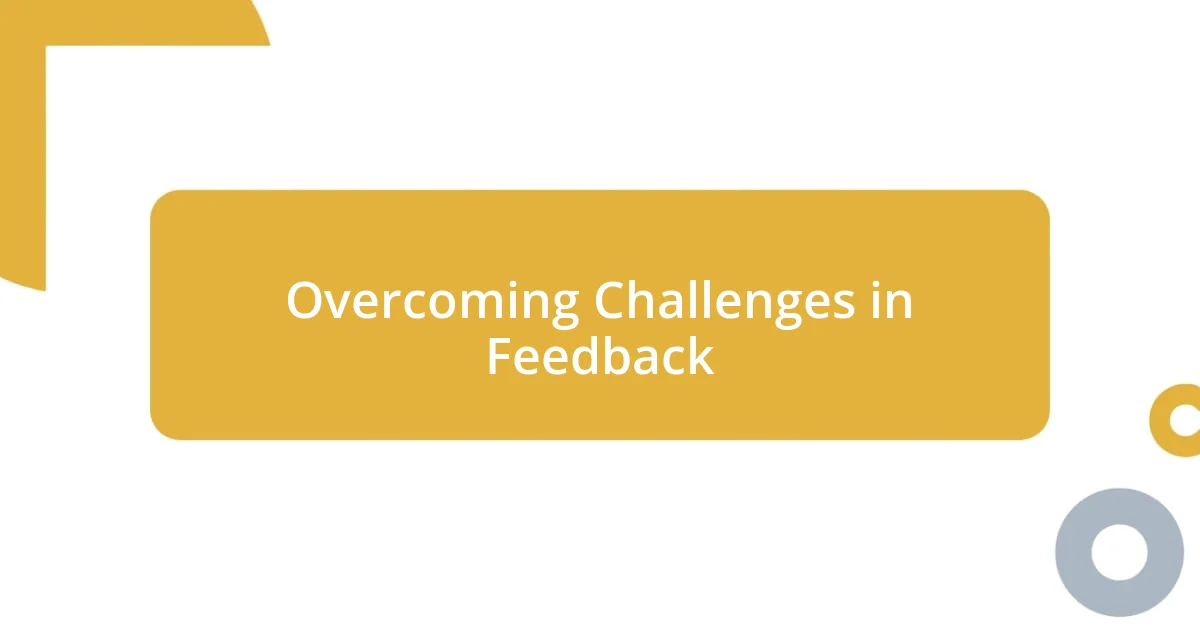
Overcoming Challenges in Feedback
Overcoming challenges in feedback requires an open heart and mind. I once faced a situation where the feedback I received felt overwhelmingly negative. Instead of shutting down, I paused and asked myself, “What can I learn here?” This shift in perspective turned my frustration into curiosity, making it easier to process the comments and use them for my growth.
It’s also important to approach feedback conversations with a clear intention. During a group project, a colleague provided feedback that initially felt harsh. Rather than reacting, I chose to engage in a dialogue by asking, “What specific changes do you think would improve our project?” This approach helped me understand their viewpoint better, transforming what could have been a conflict into a constructive exchange brimming with new ideas.
Lastly, recognizing my emotional triggers has been crucial in handling feedback. I recall a time when I received critical feedback on a presentation I had been proud of. My instinct was to defend my choices, but I took a step back, inhaled deeply, and reminded myself that growth often comes from discomfort. Embracing this discomfort has not only enhanced my ability to accept feedback, but it has also built resilience in my professional journey. How often do we let our emotions derail our growth opportunities?












